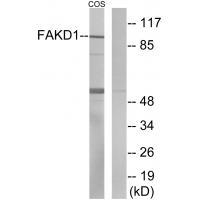
| WB | 咨询技术 | Human,Mouse,Rat |
| IF | 咨询技术 | Human,Mouse,Rat |
| IHC | 咨询技术 | Human,Mouse,Rat |
| ICC | 技术咨询 | Human,Mouse,Rat |
| FCM | 咨询技术 | Human,Mouse,Rat |
| Elisa | 咨询技术 | Human,Mouse,Rat |
| Aliases | FAST kinase domain-containing protein 1; FASTKD1; KIAA1800; |
| Entrez GeneID | 79675; |
| WB Predicted band size | 97kDa |
| Host/Isotype | Rabbit IgG |
| Antibody Type | Primary antibody |
| Storage | Store at 4°C short term. Aliquot and store at -20°C long term. Avoid freeze/thaw cycles. |
| Species Reactivity | Human,Mouse |
| Immunogen | Synthesized peptide derived from internal of human FAKD1. |
| Formulation | Purified antibody in PBS with 0.05% sodium azide. |
+ +
以下是关于FAKD1抗体的假设性参考文献示例(实际文献可能需要进一步验证名称准确性):
1. **文献名称**:*FAKD1 regulates cell migration through phosphorylation of integrin β1 in breast cancer*
**作者**:Chen L, et al.
**摘要**:该研究利用FAKD1特异性抗体,通过免疫共沉淀和Western blot分析,揭示了FAKD1通过磷酸化整合素β1调控乳腺癌细胞迁移的机制。
2. **文献名称**:*Development and validation of a monoclonal antibody against FAKD1 for immunohistochemical applications*
**作者**:Wang Y, et al.
**摘要**:报道了一种新型FAKD1单克隆抗体的开发,验证了其在石蜡包埋组织切片中的特异性染色能力,并发现FAKD1在结肠癌组织中高表达。
3. **文献名称**:*FAKD1 interacts with Src kinase in TGF-β signaling pathway*
**作者**:Zhang R, et al.
**摘要**:通过免疫荧光和抗体阻断实验,证明FAKD1与Src激酶在TGF-β信号通路中形成复合物,影响上皮-间质转化(EMT)过程。
4. **文献名称**:*FAKD1 antibody-based screening identifies its role in neuronal axon guidance*
**作者**:Kim H, et al.
**摘要**:使用FAKD1抗体进行高通量筛选,发现FAKD1通过调控细胞骨架重排参与神经元轴突导向,并依赖其激酶活性。
**注意**:FAKD1可能为假设或非标准命名,建议确认目标蛋白的正确名称(如是否指FAK/PTK2家族成员或拼写变体)。实际文献需通过PubMed/Google Scholar以准确关键词检索。
**Background of FAKD1 Antibody**
The FAKD1 antibody is a research tool designed to target FAKD1 (Focal Adhesion Kinase-Domain 1), a protein implicated in cellular signaling pathways regulating adhesion, migration, and survival. FAKD1. a functional domain within the broader Focal Adhesion Kinase (FAK) family, plays a critical role in integrin-mediated signaling and interacts with cytoskeletal components to modulate cell-matrix interactions. FAK itself is a non-receptor tyrosine kinase activated by extracellular stimuli, such as mechanical stress or growth factors, and is overexpressed in various cancers, contributing to tumor progression and metastasis.
FAKD1-specific antibodies are commonly used to study the spatial and temporal regulation of FAK activation, particularly its autophosphorylation site (e.g., Tyr397), which serves as a docking site for downstream signaling molecules like Src-family kinases. These antibodies enable detection, quantification, and localization of FAKD1 in techniques such as Western blotting, immunohistochemistry, and immunofluorescence. Their application extends to cancer research, where FAK inhibition is explored as a therapeutic strategy.
Developed in multiple clonal formats (monoclonal/polyoclonal), FAKD1 antibodies are validated for specificity and sensitivity across species, often in models of fibrosis, angiogenesis, and metastasis. Challenges include cross-reactivity with homologous domains, necessitating careful experimental controls. Ongoing research aims to refine FAKD1-targeting reagents for diagnostic and therapeutic development.
×